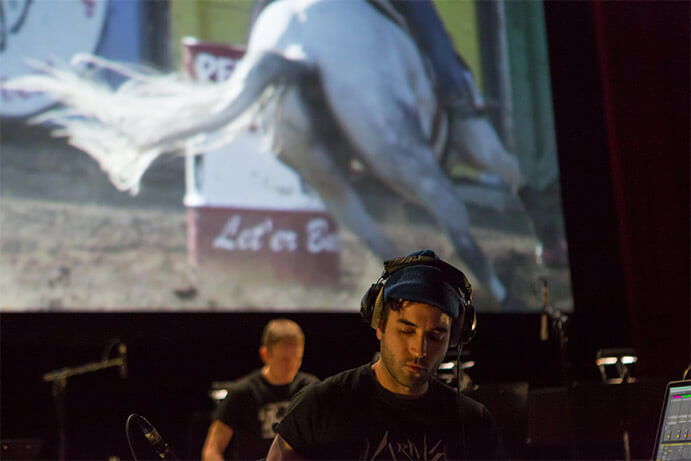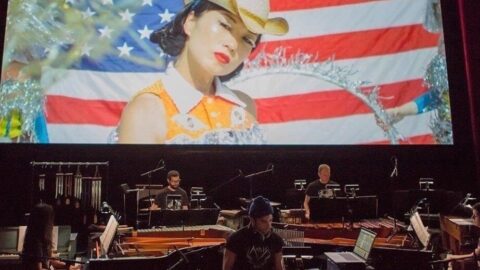Someday there ought be a few lines in this country’s historical record about Sufjan Stevens. The man has a knack when it comes to candid studies of bits and pieces of Americana, from Mary Todd Lincoln to John Wayne Gacy to the worst Christmas, ever. It’s not always rosy (“John Wayne Gacy Jr.”) but it is always honest. Where on the spectrum of light and dark does the great American rodeo fall? Your average BAM-goer likely has no proclivity towards watching humans wail on animals (or vice versa), but picking sides isn’t the point of Round-Up, Stevens’ latest collaboration with filmmakers Aaron and Alex Craig. With dallying slow-mo footage and a minimalist score, Round-Up gives viewers the opportunity to examine one of the country’s most hallowed rodeos down to the smallest shreds of tinsel and the finest tufts of fur.
Sufjan Stevens & Yarn / Wire, ROUND-UP Commissioned by BAM (Official Trailer) from Asthmatic Kitty on Vimeo.
As a musician principally known as a songwriter, Stevens does not shy away from tying his hands behind his back. In an earlier BAM commission, The BQE, he disavowed the tools with which he makes his hay: precocious narratives sounded through a shimmering voice. Instead, he directed a wordless triptych devoted to the Brooklyn-Queens Expressway, a concrete Habitrail gracing NYC’s largest land mass. Its soundtrack was a fanfare that celebrated how something so sprawling and inert can also brim with speed, action, and life. In that regard it’s hard to see The BQE without thinking of Godfrey Reggio’s qatsi trilogy. In those films, Philip Glass’ pulsating scores helped to magnify life on Earth to a point of banality. Similarly, The BQE affixed viewers’ eyes on unique angles of the everyday while their ears feasted on sparkly pomp.

Round-Up featured none of that static magnification– its cast of man and beast breathed life through the screen. With the Craigs’ gaze drawn on the Pendleton Round-Up, a staple in Oregon for over a century, every twitch and contortion was captured while Stevens’ music steadily traipsed alongside. Rather than act as a supportive base, it acted like one of the shiny hula hoops featured in the footage. It circled the action as the images roamed at 300 frames per second, an extreme slow-down that emphasized the sheen and drama of the Craig Bros’ footage. There wasn’t a single twitch or glance left unexploited. Whether the flesh and blood Marlboro man who challenged the lens in the film’s opening minutes or the lone calf to evade the lasso, the extended glimpses said a lot without saying a thing. Some faces in the crowd swelled into prideful, beaming smiles. Others contorted into masks of nauseating fear and anticipation. Still others painted the rapt focus needed for the complexities of their physical performance. The prolonged shots of animals were awe-inspiring and gut-wrenching. After all, their time on screen had nothing to do with performance. Their portraits were of naked strength and aggression founded on instinct and probably a great deal of fear.
All the while, the music looped along. While The BQE had just about a full orchestra to buttress it, Round-Up’s musical forces were lean. Stevens manned his station of electronics along with Yarn|Wire, a quartet of two percussionists and two pianists. Their sound generated an ominous but gentle push. It allowed for the images on the screen to burrow ahead as they followed. Stevens accurately described it as “almost invisible.” It draped itself imperceptibly on the peaks and troughs of the film.

Each event received its own hue. Images of a pre-show parade had a buoyant, gaudy shine and featured a rattling tambourine evocative of tribal pride. The music during Barrel Racing, where women-riders steered their steeds at breakneck speeds, was headlong. Bucking broncos are compelled to forcefully eject their passengers by means of a sort of S&M flank strap. The music during that contest droned with pretty minor chords. Other characters in the sensual circus were the hula-hooping muses who appeared again and again onscreen. Their themes were built on insistent, spinning chords that followed an assertive metric pattern.
The Pendleton Round-Up meets at a nexus of red-blooded American masculinity and endorsement-induced gaudiness. Nowhere was that fusion more evident than in Round-Up’s bull-riding scenes. The bull revealed itself like a languid leviathan breaching through the ocean’s surface. The genuinely terrified riders wore padded armor dappled with Coors and Crown Royal patches, and when the cage opened, a serene sound produced by bowed vibraphones turned to clanging cymbals and explosions of synth. In those moments, while one struggled to hold on and one sought to break free, it was hard to tell where cowboy ended and bull began. Maybe that’s the point of a rodeo– to let folks tap into the strength and courage of animals as a way to illuminate those qualities in themselves. Who knows. Round-Up doesn’t seek to answer any big questions, but with ruminative footage and a great soundtrack, it leaves a lot of space for viewers to ask some themselves.
























